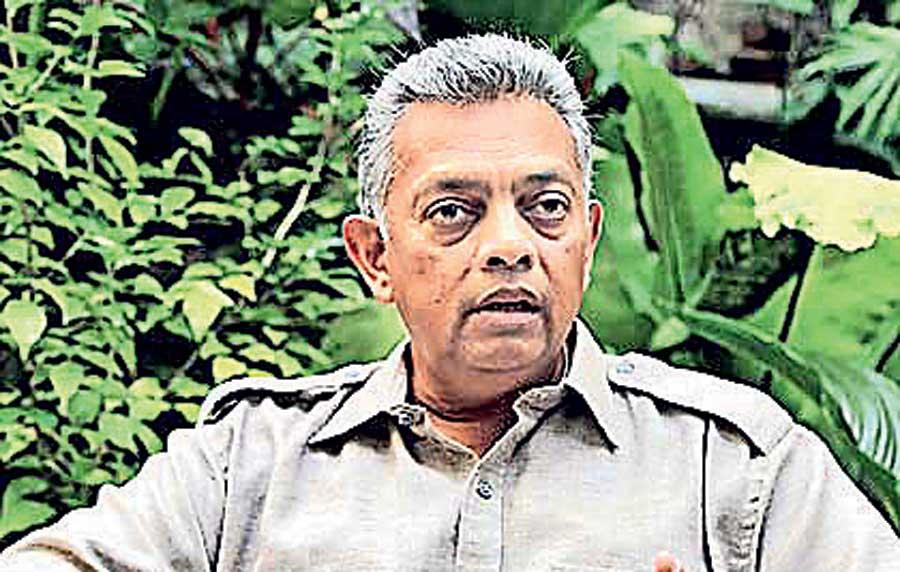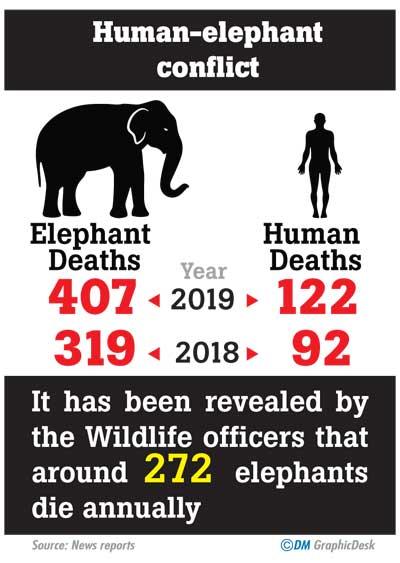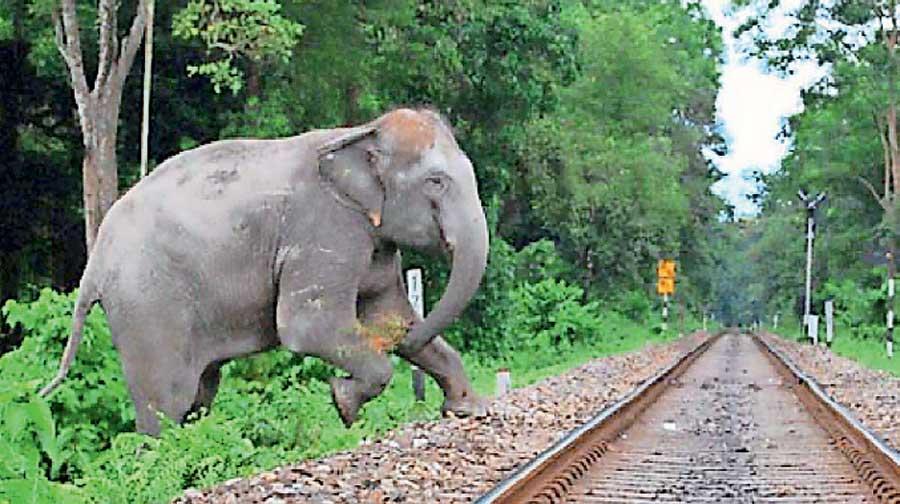01 Jan 2021 - {{hitsCtrl.values.hits}}

- Development cannot take place in the absence of ecosystem services
- We have been using one concept to manage HEC for the last 60 years
- Govt. should rethink its decision to revoke 5/2001 and 2/2006 circulars
- Radio collaring study recommended to identify elephant range and route connectivity
Sri Lanka recently set a record for the highest annual number of elephant deaths and the second highest  number of human deaths as a result of the Human-Elephant Conflict (HEC). Even though this has been a topic that resurfaces from time to time, elephant conservationists believe that successive governments have tried to address this issue from a human-centric manner. In addition, decisions to revoke forest lands circulars to give way for commercial purposes, development projects taking place sans Environmental Impact Assessments (EIA), fragmenting habitats, diminishing forest cover and encroachments into wildlife habitats are some of the key catalysts that would aggravate HEC in time to come. Therefore community-based interventions have been recommended and pilot tested in several areas of the country to control the issue. In a candid interview with the Daily Mirror, eminent wildlife researcher and former Director General at the Wildlife Conservation Department Dr. Sumith Pilapitiya shed light on the newer threats and challenges that would aggravate HEC, recommendations to identify elephant ranges and how development and ecosystem services should go
number of human deaths as a result of the Human-Elephant Conflict (HEC). Even though this has been a topic that resurfaces from time to time, elephant conservationists believe that successive governments have tried to address this issue from a human-centric manner. In addition, decisions to revoke forest lands circulars to give way for commercial purposes, development projects taking place sans Environmental Impact Assessments (EIA), fragmenting habitats, diminishing forest cover and encroachments into wildlife habitats are some of the key catalysts that would aggravate HEC in time to come. Therefore community-based interventions have been recommended and pilot tested in several areas of the country to control the issue. In a candid interview with the Daily Mirror, eminent wildlife researcher and former Director General at the Wildlife Conservation Department Dr. Sumith Pilapitiya shed light on the newer threats and challenges that would aggravate HEC, recommendations to identify elephant ranges and how development and ecosystem services should go
hand-in-glove.
Excerpts :
 Q With Sri Lanka recording the highest number of elephant deaths, what are the newer threats and challenges that have been identified in terms of conservation?
Q With Sri Lanka recording the highest number of elephant deaths, what are the newer threats and challenges that have been identified in terms of conservation?
Sri Lanka has had the highest human-elephant conflict in the world for several years. In 2019, there were around 407 elephants and 122 humans had been killed as a result of the conflict. Some politicians perceive that this was because the number of elephants has increased in Sri Lanka. There is absolutely no data to back that up. What is happening is that the humans and the elephants are coming into contact more frequently than in the past and that is resulting in the deaths of both humans and elephants. There is a couple of reasons for this. Humans are encroaching into elephant habitats, in the name of development and over the years, elephants have been subject to significant harassment by humans; being shot at by farmers when raiding crops, being disturbed when elephant drives initiated by the Department of Wildlife Conservation (DWC) at the insistence of political authorities. Elephants, like any other wild animal or even a human being reacts to what is being done to them. When we show aggression to elephants, they respond with aggression.
So the more we harass the elephants, more conflicts we create with them. The more we shrink the forest ecosystems in the name of development in areas where the elephants roam freely, without taking adequate measures to manage elephants, more and more conflicts we can expect. It is not that I am opposed to development taking place in Sri Lanka, but I am calling on the authorities to plan the development well, without focusing only on the specific project that is being planned, but take a landscape approach to planning. The greatest threat to conservation of wildlife in general and elephants in particular is unplanned, politically-expedient development. With minimal effort of coordinating with stakeholders and willingness to compromise, Sri Lanka could pursue its development objectives while conserving its natural resources
and biodiversity.
"In 2019, there were around 407 elephants and 122 humans had been killed as a result of the conflict. Some politicians perceive that this was because the number of elephants has increased in Sri Lanka"
Many development planners and politicians in Sri Lanka haven’t fully appreciated the linkage and dependency between robust ecosystems and development. Development cannot take place in the absence of ecosystem services. These are services that ecosystems provide such as availability of water, fertile soils, climate control and weather, to name a few. Science has demonstrated that higher the biodiversity of ecosystems, the greater the services such ecosystems can provide. The greater the ecosystem services, greater the opportunity for development. Therefore, robust ecosystem structures are crucial for development. Planning development in a manner that does not compromise ecosystem service provision and it is therefore the way forward for Sri Lanka’s development. But will the political authorities pay attention to science is the million
dollar question!
Q What sort of policy-level interventions are required to mitigate HEC?
If the Government is serious about mitigating HEC, then there has to be a paradigm shift in the way HEC is being managed. For the past 60 years, we have been using one concept to manage HEC. The concept is that all elephants should be confined to protected areas and fenced in. We have tried this for 60 years and failed. Had we succeeded, by now HEC should have been on the decline. In reality, the opposite is happening. Why is this? This is because we have been trying to address HEC in a human-centric manner. Successive Governments decide that elephants should be confined to protected areas, and the DWC is instructed to do so. It takes several years to erect fences and drive elephants into the protected areas. By the time, we realize that this approach does not work and that the elephants are still outside the protected areas, the Government or the politicians who proposed this are no longer in power. The new Government too has ordered the same old thing – driving the elephants into protected areas and keeping them behind the fences. Before they realize that this approach has failed, the next Government and next group of politicians are in power and repeat the same thing. We have been practicing this for the past 60 years and failed. If the present regime tries this, and there are some indications that they are trying the same old thing, with the addition of trenches in front of the fences, they too would fail, and there is absolutely no doubt in my mind.
managed. For the past 60 years, we have been using one concept to manage HEC. The concept is that all elephants should be confined to protected areas and fenced in. We have tried this for 60 years and failed. Had we succeeded, by now HEC should have been on the decline. In reality, the opposite is happening. Why is this? This is because we have been trying to address HEC in a human-centric manner. Successive Governments decide that elephants should be confined to protected areas, and the DWC is instructed to do so. It takes several years to erect fences and drive elephants into the protected areas. By the time, we realize that this approach does not work and that the elephants are still outside the protected areas, the Government or the politicians who proposed this are no longer in power. The new Government too has ordered the same old thing – driving the elephants into protected areas and keeping them behind the fences. Before they realize that this approach has failed, the next Government and next group of politicians are in power and repeat the same thing. We have been practicing this for the past 60 years and failed. If the present regime tries this, and there are some indications that they are trying the same old thing, with the addition of trenches in front of the fences, they too would fail, and there is absolutely no doubt in my mind.
Governments and politicians have never analyzed the reasons for this approach failing, but continue trying the same tried-tested-failed method, hoping that this time since a new regime is trying it, that it would succeed. Researchers like us have analyzed the reasons for the failure. The first thing that we have to understand is that we cannot make the elephants to do what we want. We have to understand elephant biology, ranging patterns and their behaviour, and take that into account in developing a solution to HEC mitigation. The first thing we have to understand is that we cannot eliminate HEC. To eliminate HEC, we either have to have no elephants or no people. All we can do is to minimize the conflict by transforming the human-elephant conflict to that of human-elephant coexistence. We must realize that electric fences are not erected to protect elephants. They are to protect humans, property and crops from elephant depredation. If the fence is to protect the people, property and crops, where should the fences be located? Should they be in the middle of the jungles or located around villages and cultivation land? Therefore, the first thing to do is to relocate electric fences to protect what needs to
be protected.
"In 2019, there were around 407 elephants and 122 humans had been killed as a result of the conflict. Some politicians perceive that this was because the number of elephants has increased in Sri Lanka"
Community-based village electric fences and seasonal agricultural fences have been pilot tested in about 50 locations in Sri Lanka by the Centre for Conservation and Research (CCR). There are such fences operational in the Kurunegala, Anuradhapura, Trincomalee and Hambantota Districts. Many of these fences have been operating successfully for over eight years. Delegations from India, Malaysia and Myanmar visited these pilot projects and adopted the lessons learnt in human-elephant conflict mitigation in their countries. Representatives of 13 African countries visited these pilot sites in Sri Lanka in 2017 to learn from these experiences. It is a sad note that our political authorities and bureaucrats are not interested in visiting such sites and learning from the experiences of these successful projects, and instead stay mired in tried and failed approaches. Fortunately, President Gotabaya Rajapakse appointed a Presidential Committee to develop a National Action Plan for HEC Mitigation. The Committee has recommended that the Government immediately commences a programme of community-based village and seasonal agricultural fencing, as the primary means of HEC mitigation. Immediate benefits to communities would be observed if this programme is implemented. The critical difference between this programme and the failed approaches of the past is that we are recommending that elephants should not be confined to protected areas, but protect humans, property and crops, while coexisting with elephants within that landscape. Coexisting with elephants with minimal conflict has been the practices for centuries by the local tribal community and in remote ancient villages. They coexist with elephants even without fences. With fences to protect villages and crops, we should be able to coexist in the landscape with elephants with minimal conflict.
Q The revoking of the 5/2001 and 2/2006 circulars have posed newer challenges to the environment. The removal of elephant corridors would have adverse impacts on elephants. What are the consequences you see here?
Habitat connectivity is essential for species like elephants that have large home ranges. The more we shrink the forest habitat that provides connectivity between protected areas, the greater is the possibility of elephants coming into contact with humans and aggravating the conflict. Land for agricultural development appears to be a priority for this Government. Agricultural development of a country is measured not by the land area under cultivation, but on the agricultural productivity of the land. Sri Lanka’s agricultural productivity or yield per acre is quite low. Shouldn’t the more rational approach to development of agriculture in Sri Lanka be focused on increasing productivity per unit area of land, before opening up more land for development? The President’s manifesto clearly states that he is committed to increase forest cover in Sri Lanka by 30%. I find the Government’s move to revoking 5/2001 and 2/2006 so that forest land can be opened up for development perplexing, since the Government also seems to be trying to grow more trees. I don’t think one needs to be a “rocket scientist” to grasp that protecting existing forest is better than destroying it and trying to grow new trees. Therefore, I think that the Government needs to seriously re-think its decision to revoke Circulars 5/2001 and 2/2006.
Q There are several elephant corridors that are yet to be gazetted. Shouldn’t this be a topmost priority?
Connectivity of elephant range is critical to minimize HEC. These proposed elephant corridors were identified years ago, largely based on anecdotal evidence. The originally identified corridors have been encroached and developed in many areas. Therefore, elephant ranging patterns may have changed due to human impediments over the years. So before rushing into gazetting the corridors, I would first recommend that a number of elephants in the areas of the originally identified elephant corridors be radio-collared and their movements studied for at least a year and then determine which areas are needed for connectivity and corridors. Elephants are adaptive and their movements may have changed over the years. So I would strongly recommend a radio-collaring study to identify their range and then decide on the routes of connectivity. In my view, without having a good understanding of elephant ranging patterns, gazetting the previously proposed corridors may be futile.

"With minimal effort of coordinating with stakeholders and willingness to compromise, Sri Lanka could pursue its development objectives while conserving its natural resources and biodiversity"
Q Elephants are threatened with the laying of snares. Is there any solution to the continuation of this
illegal practice?
Snares are not laid for elephants. They are laid for poaching smaller wildlife like deer and wild boar. But elephants, especially calves and juveniles become unintended victims. Snares have resulted in many claves and juveniles being disabled, with their trunks cut, sometimes right through which makes it impossible for them to eat or drink and they starve to death. This practice need to stop. The only way to ensure this practice stop is for the Department of Wildlife Conservation to strengthen their anti-poaching operations. Regular and systematic anti-poaching operations will contribute towards a reduction in the laying of snares.
Q Are there any other ways for people to keep elephants away other than using hakkapatas and Fire crackers?
Hakka Patas and fire crackers are used to keep elephants away from human settlements and crops. The best way for people to keep elephants away from their homes and crops is to have community-based village and seasonal agricultural fences. These fences are specifically to keep elephants out of settlements and cultivation. These are different from the traditional electric fences which are erected to keep elephants within forests. This has failed for 60 years so it is time to focus on a new approach. The seasonal agricultural fence is erected at the beginning of the cultivation season and removed as soon as the crop is harvested, allowing elephants to feed on the crop residue. This is an excellent system of coexistence and also has opportunities for community-based elephant-viewing tourism. If we want to keep people from harming elephants, we need to convert elephants from an economic liability to an economic asset. Community based elephant-viewing tourism could be an avenue to ensure that this conversion takes place.
Q Construction of highways and other commercial projects in areas such as Hambantota could restrict elephant movement. What needs to be kept in mind when looking at Development in such areas?
Development planning should be done taking elephant ranging patterns into account when the development project is designed. Elephants have to be taken into consideration at the conceptual design stage. Radio-collaring of elephants will provide information on where elephants cross the proposed highways, therefore locations for overpasses and underpasses for elephant movement could be designed based on this data. If the Government wants development projects to succeed in areas of elephant range, then elephant movement patterns should be included in the project without hindering it. If so, coexistence between elephants and the development project may be possible. If this is neglected, the development project’s sustainability would be a serious question.
"Robust ecosystem structures are crucial for development. Planning development in a manner that does not compromise ecosystem service provision and it is therefore the way forward for Sri Lanka’s development"
Q Most projects are now done sans EIAs. To what degree does this pose a threat to wildlife, including elephants?
The National Environmental Act (NEA) prescribes what projects need EIAs. That is the law. If all projects prescribed to undertake EIAs to do so, the problem can be minimized. If political pressure results in Government agencies compromising on the EIA quality and its assessment, the looser is Sri Lanka as a nation. Because of the problem that could arise whether or not the EIA identifies it. It is up to the Government to ensure that the laws of the land are enforced and done so effectively. If that happens, then wildlife and development can coexist, but with some compromise, made by both developers and environmentalists.
Q There were some proposals to implement novel solutions to mitigate HEC. Some of them include different kinds of electric fences etc. But they seemed to be short-lived and impractical. What are your observations on this?
Any novel solution should be systematically tested and documented prior to public funds being invested in large scale application. New ideas are always good, provided it must be systematically piloted before large scale implementation. After all, the authorities should be held accountable for spending public funds and therefore they should be able to assure the authorities and the public that the investments on novel inventions are feasible.
Q How could DWC officials improve their services such as rescue protocols, if they come across an injured or a sick elephant?
The DWC should have protocols for dealing with an injured or sick elephant. To be fair by the DWC, the DWC Vets, we must realize that the Veterinary Medicine degree in the Universities in Sri Lanka focus on livestock veterinary medicine. Other than one subject on wildlife veterinary medicine, the focus of the course is livestock veterinary medicine. This is somewhat different from wildlife veterinary medicine. Therefore, the DWC Vets have to be commended for learning their field on the job.
09 Jan 2025 5 hours ago
09 Jan 2025 6 hours ago
09 Jan 2025 9 hours ago
09 Jan 2025 9 hours ago
09 Jan 2025 09 Jan 2025